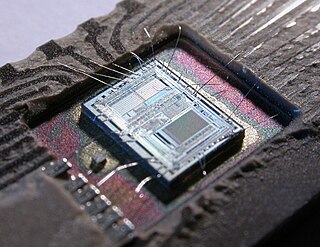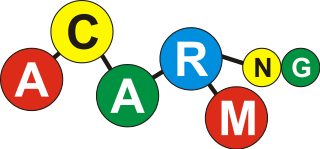Related Research Articles

In computing, a database is an organized collection of data stored and accessed electronically. Small databases can be stored on a file system, while large databases are hosted on computer clusters or cloud storage. The design of databases spans formal techniques and practical considerations, including data modeling, efficient data representation and storage, query languages, security and privacy of sensitive data, and distributed computing issues, including supporting concurrent access and fault tolerance.

In digital computers, an interrupt is a request for the processor to interrupt currently executing code, so that the event can be processed in a timely manner. If the request is accepted, the processor will suspend its current activities, save its state, and execute a function called an interrupt handler to deal with the event. This interruption is often temporary, allowing the software to resume normal activities after the interrupt handler finishes, although the interrupt could instead indicate a fatal error.

A microcontroller is a small computer on a single VLSI integrated circuit (IC) chip. A microcontroller contains one or more CPUs along with memory and programmable input/output peripherals. Program memory in the form of ferroelectric RAM, NOR flash or OTP ROM is also often included on chip, as well as a small amount of RAM. Microcontrollers are designed for embedded applications, in contrast to the microprocessors used in personal computers or other general purpose applications consisting of various discrete chips.

PostgreSQL, also known as Postgres, is a free and open-source relational database management system (RDBMS) emphasizing extensibility and SQL compliance. It was originally named POSTGRES, referring to its origins as a successor to the Ingres database developed at the University of California, Berkeley. In 1996, the project was renamed to PostgreSQL to reflect its support for SQL. After a review in 2007, the development team decided to keep the name PostgreSQL and the alias Postgres.
In computing, a computer program or subroutine is called reentrant if multiple invocations can safely run concurrently on multiple processors, or on a single-processor system, where a reentrant procedure can be interrupted in the middle of its execution and then safely be called again ("re-entered") before its previous invocations complete execution. The interruption could be caused by an internal action such as a jump or call, or by an external action such as an interrupt or signal, unlike recursion, where new invocations can only be caused by internal call.
A database engine is the underlying software component that a database management system (DBMS) uses to create, read, update and delete (CRUD) data from a database. Most database management systems include their own application programming interface (API) that allows the user to interact with their underlying engine without going through the user interface of the DBMS.
JTAG is an industry standard for verifying designs and testing printed circuit boards after manufacture.

In concurrent programming, an operation is linearizable if it consists of an ordered list of invocation and response events, that may be extended by adding response events such that:
- The extended list can be re-expressed as a sequential history.
- That sequential history is a subset of the original unextended list.
The Access Database Engine is a database engine on which several Microsoft products have been built. The first version of Jet was developed in 1992, consisting of three modules which could be used to manipulate a database.
In a database, a view is the result set of a stored query, which can be queried in the same manner as a persistent database collection object. This pre-established query command is kept in the data dictionary. Unlike ordinary base tables in a relational database, a view does not form part of the physical schema: as a result set, it is a virtual table computed or collated dynamically from data in the database when access to that view is requested. Changes applied to the data in a relevant underlying table are reflected in the data shown in subsequent invocations of the view.
A "production system " is a computer program typically used to provide some form of artificial intelligence, which consists primarily of a set of rules about behavior but it also includes the mechanism necessary to follow those rules as the system responds to states of the world. Those rules, termed productions, are a basic representation found useful in automated planning, expert systems and action selection.
A search engine is an information retrieval software program that discovers, crawls, transforms, and stores information for retrieval and presentation in response to user queries.
Kinetic Rule Language (KRL) is a rule-based programming language for creating applications on the Live Web. KRL programs, or rulesets, comprise a number of rules that respond to particular events. KRL has been promoted as language for building personal clouds.
Microsoft SQL Server is a proprietary relational database management system developed by Microsoft. As a database server, it is a software product with the primary function of storing and retrieving data as requested by other software applications—which may run either on the same computer or on another computer across a network. Microsoft markets at least a dozen different editions of Microsoft SQL Server, aimed at different audiences and for workloads ranging from small single-machine applications to large Internet-facing applications with many concurrent users.
Database caching is a process included in the design of computer applications which generate web pages on-demand (dynamically) by accessing backend databases.

ConceptBase is a deductive and object-oriented database management system developed at University of Skövde. Earlier development was done at University of Passau (1987-1992), University of Aachen (1992-2003), and University of Tilburg (1997-2013). It is mainly used for conceptual modeling and metamodeling in the domain of software engineering and related domains. ConceptBase.cc is free and open-source software.
Event-driven SOA is a form of service-oriented architecture (SOA), combining the intelligence and proactiveness of event-driven architecture with the organizational capabilities found in service offerings. Before event-driven SOA, the typical SOA platform orchestrated services centrally, through pre-defined business processes, assuming that what should have already been triggered is defined in a business process. This older approach does not account for events that occur across, or outside of, specific business processes. Thus complex events, in which a pattern of activities—both non-scheduled and scheduled—should trigger a set of services is not accounted for in traditional SOA 1.0 architecture.

A Hardware Trojan (HT) is a malicious modification of the circuitry of an integrated circuit. A hardware Trojan is completely characterized by its physical representation and its behavior. The payload of an HT is the entire activity that the Trojan executes when it is triggered. In general, Trojans try to bypass or disable the security fence of a system: for example, leaking confidential information by radio emission. HTs also could disable, damage or destroy the entire chip or components of it.
UML state machine, also known as UML statechart, is an extension of the mathematical concept of a finite automaton in computer science applications as expressed in the Unified Modeling Language (UML) notation.

ACARM-ng is an open source IDS/IPS system. ACARM-ng is an alert correlation software which can significantly facilitate analyses of traffic in computer networks. It is responsible for collection and correlation of alerts sent by network and host sensors, also referred to as NIDS and HIDS respectively. Correlation process aims to reduce the total number of messages that need to be viewed by a system administrator to as few as possible by merging similar events into groups representing logical pieces of malicious activity.
References
- Klaus R. Dittrich, Stella Gatziu, Andreas Geppert: The Active Database Management System Manifesto: A Rulebase of ADBMS Features. Lecture Notes in Computer Science 985, Springer 1995, ISBN 3-540-60365-4, pages 3–20.